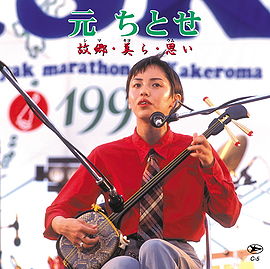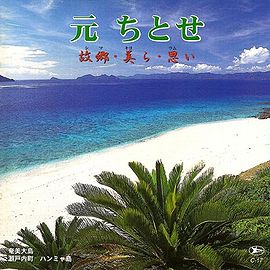Shima Kyora Umui: Difference between revisions
No edit summary |
CrypticTokyo (talk | contribs) mNo edit summary |
||
| (One intermediate revision by the same user not shown) | |||
| Line 1: | Line 1: | ||
[[ | [[File:shimakyoraumui.jpg|thumb|270px|right|First Press Cover]] | ||
[[ | [[File:reshimakyoraumui.jpg|thumb|270px|right|Second Press Cover]] | ||
; Artist | |||
: [[Hajime Chitose]] | |||
; Album | |||
: Shima・Kyora・Umui (故郷・美ら・思い; ''Hometown.Beautiful.Thoughts'') | |||
; Released | |||
: 1996.11.xx <small>(First Press)</small> | |||
: 2002.06.10 <small>(Second Press)</small> | |||
; Catalog Number | |||
: C-5 <small>(First Press)</small> | |||
: C-17 <small>(Second Press)</small> | |||
; Price | |||
: ¥3,500 <small>(First Press)</small> | |||
: ¥3,150 <small>(Second Press)</small> | |||
; | ; Tracklist | ||
[[Hajime Chitose]] | # [[Asabana (Hajime Chitose)|Asabana-bushi]] (朝花節) | ||
# [[Naga Asabana (Hajime Chitose)|Naga Asabana-bushi]] (長朝花節) | |||
# [[Shunjoshu (Hajime Chitose)|Shunjoshu-bushi]] (俊良主節) | |||
# [[Kurudando (Hajime Chitose)|Kurudando-bushi]] (くるだんど節) | |||
# [[Kantsume (Hajime Chitose)|Kantsume-bushi]] (かんつめ節) | |||
# [[Shunkane (Hajime Chitose)|Shunkane-bushi]] (シュンカネ節) | |||
# [[Rankanboshi (Hajime Chitose)|Rankanboshi-bushi]] (らんかん橋節) | |||
# [[Amagurumi (Hajime Chitose)|Amagurumi-bushi]] (雨黒み節) | |||
# [[Shumichi Nagahama (Hajime Chitose)|Shumichi Nagahama-bushi]] (塩道長浜節) | |||
# [[Kadoku Nabekana (Hajime Chitose)|Kadoku Nabekana-bushi]] (嘉徳なべ加那節) | |||
# [[Kunnyori Yoneago (Hajime CHitose)|Kunnyori Yoneago-bushi]] (国直よね姉節) | |||
# [[Nagakumo (Hajime Chitose)|Nagakumo-bushi]] (長雲節) | |||
# [[Muchakana (Hajime Chitose)|Muchakana-bushi]] (むちゃ加那節) | |||
# [[Choukikujo (Hajime Chitose)|Choukikujo]] (ちょうきく女) | |||
# [[Itokuri (Hajime Chitose)|Itokuri-bushi]] (糸繰り節) | |||
# [[Yoisura (Hajime Chitose)|Yoisura-bushi]] (ヨイスラ節) | |||
# [[Ikyunnyakana (Hajime Chitose)|Ikyunnyakana-bushi]] (行きゅんにゃ加那節) | |||
# [[Ikyoure (Hajime Chitose)|Ikyoure-bushi]] (行きょうれ節) | |||
# [[Kubanuha (Hajime Chitose)|Kabanuha-bushi]] (くばぬ葉節) | |||
# [[Magaryo Takachidi (Hajime Chitose)|Magaryo Takachidi-bushi]] (曲りょ高頂節) | |||
# [[Shogachigin (Hajime Chitose)|Shogachigin]] (正月着物) | |||
# [[Hounen (Hajime Chitose)|Hounen-bushi]] (豊年節) | |||
[[Category:J- | <div align="justify"> | ||
; Information | |||
''Shima・Kyora・Umui'' is the second album released by [[Hajime Chitose]]. It is a cover album of [[:Category:Shima-Uta|Shima-Uta]] songs sung in the [[Wikipedia:Amami language|Amami language]], including many songs re-recorded from her debut album ''[[Higya Merabe]]''. She recorded and released this album after she won the Amami Folk Song Grand Prize Award in 1996. She was in her third year of high school at the time, and is the youngest winner of the prize to date. [[Moriyama Yoriko]] accompanied Hajime on tracks #1 to #4, #7, #10, #13, #15, and #17 to #20. [[Nakano Sueko]] accompanied Hajime on tracks #5, #6, #8, #9, #11, #12, #14, #16, #21, and #22. | |||
The album was reprinted about six years later by ''Central Gakki'' records after Hajime signed a major label record deal with [[Sony Music Entertainment#EPIC Records|EPIC Records]]. The differences between this pressing and the first pressing is a renewed album CD jacket and a cheaper price. Both of these presses along with her debut album are hard to find as ''Central Gakki'' only distributes their releases in the [[Wikipedia:Ryukyu Islands|Ryukyu Islands]] in limited quantites. They are, however, available through the label's official online shop. | |||
</div> | |||
==External Links== | |||
* [http://www.oricon.co.jp/music/release/d/478467/1/ Oricon Profile] | |||
* [http://www.simauta.net/hajime_chitose.html Hajime Chitose Central Gakki Discography] | |||
[[Category:J-Folk (releases)]] | |||
[[Category:Shima-Uta (releases)]] | [[Category:Shima-Uta (releases)]] | ||
[[Category: | [[Category:1996 Albums]] | ||
[[Category:2002 Albums]] | [[Category:2002 Albums]] | ||
[[Category:Cover Album]] | |||
Latest revision as of 10:52, 14 May 2011


- Artist
- Hajime Chitose
- Album
- Shima・Kyora・Umui (故郷・美ら・思い; Hometown.Beautiful.Thoughts)
- Released
- 1996.11.xx (First Press)
- 2002.06.10 (Second Press)
- Catalog Number
- C-5 (First Press)
- C-17 (Second Press)
- Price
- ¥3,500 (First Press)
- ¥3,150 (Second Press)
- Tracklist
- Asabana-bushi (朝花節)
- Naga Asabana-bushi (長朝花節)
- Shunjoshu-bushi (俊良主節)
- Kurudando-bushi (くるだんど節)
- Kantsume-bushi (かんつめ節)
- Shunkane-bushi (シュンカネ節)
- Rankanboshi-bushi (らんかん橋節)
- Amagurumi-bushi (雨黒み節)
- Shumichi Nagahama-bushi (塩道長浜節)
- Kadoku Nabekana-bushi (嘉徳なべ加那節)
- Kunnyori Yoneago-bushi (国直よね姉節)
- Nagakumo-bushi (長雲節)
- Muchakana-bushi (むちゃ加那節)
- Choukikujo (ちょうきく女)
- Itokuri-bushi (糸繰り節)
- Yoisura-bushi (ヨイスラ節)
- Ikyunnyakana-bushi (行きゅんにゃ加那節)
- Ikyoure-bushi (行きょうれ節)
- Kabanuha-bushi (くばぬ葉節)
- Magaryo Takachidi-bushi (曲りょ高頂節)
- Shogachigin (正月着物)
- Hounen-bushi (豊年節)
- Information
Shima・Kyora・Umui is the second album released by Hajime Chitose. It is a cover album of Shima-Uta songs sung in the Amami language, including many songs re-recorded from her debut album Higya Merabe. She recorded and released this album after she won the Amami Folk Song Grand Prize Award in 1996. She was in her third year of high school at the time, and is the youngest winner of the prize to date. Moriyama Yoriko accompanied Hajime on tracks #1 to #4, #7, #10, #13, #15, and #17 to #20. Nakano Sueko accompanied Hajime on tracks #5, #6, #8, #9, #11, #12, #14, #16, #21, and #22.
The album was reprinted about six years later by Central Gakki records after Hajime signed a major label record deal with EPIC Records. The differences between this pressing and the first pressing is a renewed album CD jacket and a cheaper price. Both of these presses along with her debut album are hard to find as Central Gakki only distributes their releases in the Ryukyu Islands in limited quantites. They are, however, available through the label's official online shop.